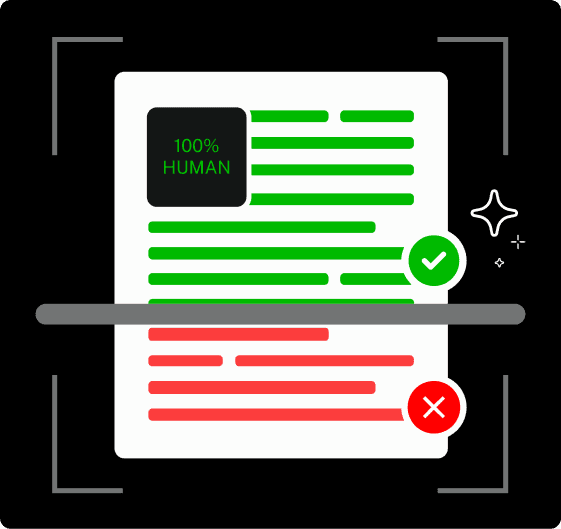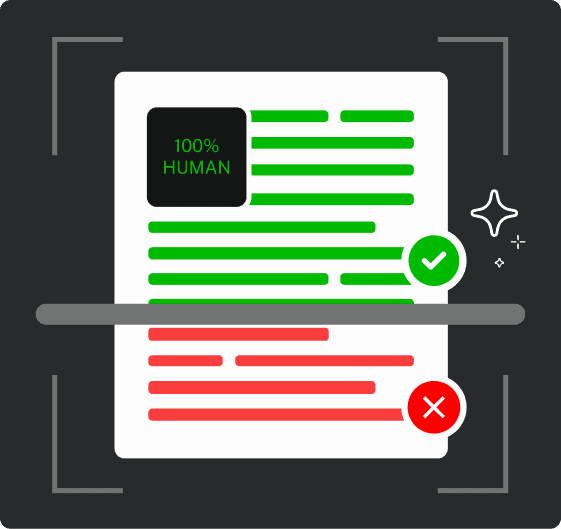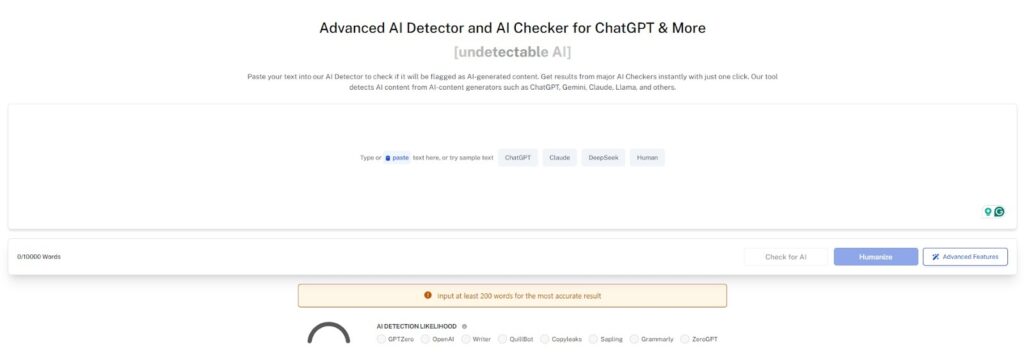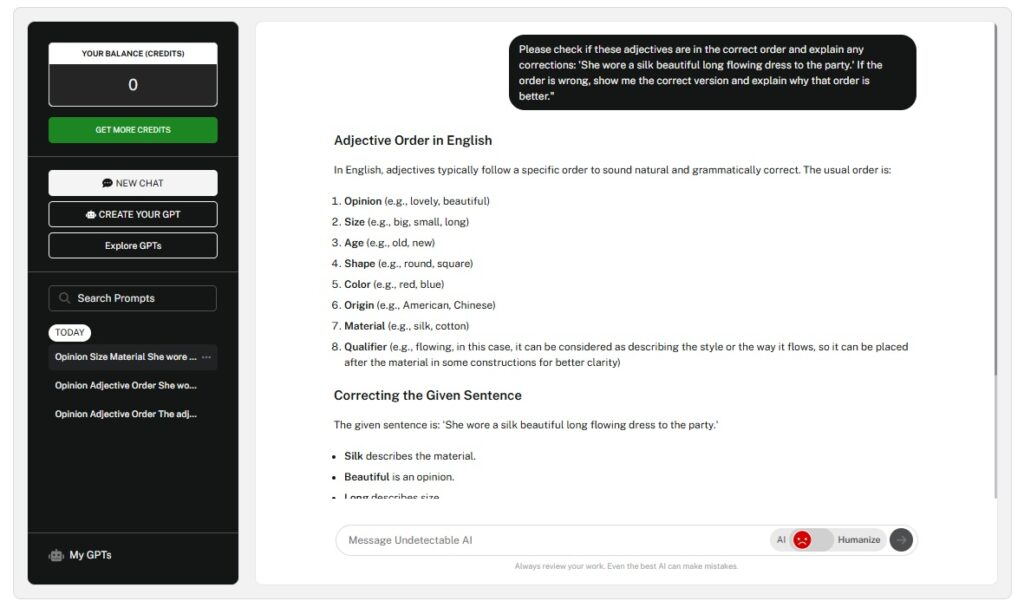We can all agree that giving and receiving compliments feels great.
That mix of validation and a dopamine boost can perk you up better than coffee.
Compliments are easy to give, but getting them right takes a little more effort than you’d expect sometimes.
If you wanted to compliment your friend on their “beautiful little black dress,” but tripped up on the adjectives, you might say “black little beautiful dress” instead.
Sounds strange and awkward, right?
This is where the order of adjectives plays its part.
Often overlooked, this rule shapes how we talk about everything, from what Zendaya wore at The MET Gala to your favorite cat videos.
Ignore these rules and you’ll end up sounding like you’re playing Taboo, just throwing out random words.
This guide breaks down everything you need to know about adjective order.
You’ll learn the rules, review practical examples, and discover tools that can help you master this tricky aspect of English grammar.
Key Takeaways
- English adjectives follow a specific order that native speakers use naturally
- The standard order is: opinion, size, age, shape, color, origin, material, purpose
- Breaking adjective order makes sentences sound awkward and confusing
- Practice and AI tools can help you internalize the correct patterns
- There are some exceptions, but the basic rule applies in most situations
What Is the Order of Adjectives?
The order of adjectives is the sequence that multiple adjectives must follow when describing a single noun.
Think of it as grammar’s way of organizing descriptive words so they flow naturally and make sense to listeners.
This rule caught fire in 2016, when The Elements of Eloquence by Mark Forsyth went viral after an excerpt explaining it was shared widely on social media.


Never Worry About AI Detecting Your Texts Again. Undetectable AI Can Help You:
- Make your AI assisted writing appear human-like.
- Bypass all major AI detection tools with just one click.
- Use AI safely and confidently in school and work.
The tweet, pulled from Forsyth’s book, revealed the hidden hierarchy and immediately sparked a flurry of “mind‑blown” reactions.
BBC Culture’s Matthew Anderson posted it to Twitter, and it exploded (racking up over 44,000 retweets and 66,000 likes) because it exposed a complex rule that English speakers follow intuitively
Forsyth laid it out simply and memorably:
“Opinion, Size, Age, Shape, Colour, Origin, Material, Purpose, Noun.”
When you use multiple adjectives, they can’t just appear in any random order.
There’s a hierarchy that determines which type of adjective comes first, second, third, and so on.
This isn’t just a style preference. It’s how English naturally organizes information about nouns.
The rule exists because of how our brains process descriptive information.
We typically think about subjective qualities first (like whether something is beautiful or ugly), then move to more objective, measurable qualities (like size and color), and finally to categorical information (like what the object is made of or used for).
The Standard Order of Adjectives in English

Here’s the standard order that adjectives follow in English:
- Opinion (beautiful, ugly, nice, awful)
- Size (big, small, tiny, huge)
- Age (old, new, young, ancient)
- Shape (round, square, long, short)
- Color (red, blue, green, black)
- Origin (American, Chinese, European, local)
- Material (wooden, plastic, metal, cotton)
- Purpose (sleeping bag, running shoes, dining table)
So, when you describe a piece of furniture, you’d say “beautiful big old round red Chinese wooden dining table” rather than randomly mixing up the order.
Most of the time, you won’t use all eight categories at once.
That would create incredibly long and clunky sentences.
Typically, you’d use two to four adjectives maximum. But when you do use multiple adjectives, this order keeps your writing smooth and natural.
Remember this mnemonic device: Opinions Seem Always So Clear On Most Points. Each first letter corresponds to the adjective categories in order.
Why Does the Order of Adjectives Matter?
Following the correct order of adjectives isn’t just about sounding grammatically correct.
It’s about effective communication. When adjectives appear in the wrong order, sentences become harder to process and understand.
Native English speakers have internalized these patterns from childhood.
When they hear adjectives in the wrong order, it creates a mental hiccup.
The sentence feels off, even if the meaning is still clear. This can distract from your message and make your writing seem less polished.
For non-native speakers, mastering adjective order is crucial for sounding natural and fluent.
It’s one of those subtle aspects of English that can instantly reveal whether someone has truly mastered the language’s rhythm and flow.
Writers who understand adjective order can craft more elegant and readable sentences.
Instead of stumbling over awkward phrasing, they can focus on choosing the most impactful descriptive words and arranging them for maximum effect.
If you’re working on academic writing, professional communication, or creative projects, getting adjective order right shows attention to detail and linguistic sophistication.
It’s a small consideration that makes a big difference in how polished your writing appears.

Need help getting familiar with the rule? Consider using Undetectable AI’s AI Humanizer to adjust sentence tone and flow to sound more natural.
This tool can help identify when your adjective order feels robotic or unnatural, suggesting improvements that make your writing flow better.
Examples of Correct and Incorrect Adjective Order
Let’s look at some concrete examples to see how adjective order works in practice.
Correct Examples:
- “She bought a gorgeous small antique round silver Italian metal jewelry box.”
- “He drives an impressive large new rectangular black German steel luxury car.”
- “They live in a charming tiny old square yellow American wooden cottage.”
- “I need comfortable medium-sized modern oval brown leather shoes.”
Incorrect Examples:
- “She bought a silver small gorgeous antique Italian round metal jewelry box.” (Mixed up order)
- “He drives a German black large impressive new steel rectangular luxury car.” (Completely scrambled)
- “They live in a wooden yellow square old tiny American charming cottage.” (Backwards order)
- “I need brown leather oval modern medium-sized comfortable running shoes.” (Random arrangement)
Notice how the incorrect examples feel clunky and hard to follow?
Your brain has to work harder to process the information when adjectives appear out of order.
Here are some everyday examples that show the difference:
- Natural: “That beautiful big old brick house”
- Awkward: “That brick old big beautiful house”
- Natural: “Those expensive new Italian leather boots”
- Awkward: “Those Italian leather new expensive boots”
- Natural: “A wonderful small round wooden table”
- Awkward: “A wooden round small wonderful table”
The pattern becomes clear once you see multiple examples.
The correct order feels smooth and effortless, while the incorrect order creates friction that slows down comprehension.
Tips for Remembering the Order of Adjectives
Mastering adjective order takes practice, but these strategies can help you internalize the pattern faster.
- Start with the mnemonic: Opinions Seem Always So Clear On Most Points. Write it down and practice until you can recall it instantly. Having this mental framework makes it easier to place adjectives correctly.
- Focus on common combinations: Most writing uses only two or three adjectives at once. Practice with frequent pairings like opinion + color (“beautiful red dress”) or size + material (“big wooden spoon”). Master these shorter combinations before attempting longer sequences.
- Read aloud: Your ear can often catch what your eye misses. When you read sentences with multiple adjectives out loud, the incorrect order becomes more obvious. If something sounds off, check the adjective sequence.
- Study native speaker writing: Pay attention to how professional writers, journalists, and published authors arrange their adjectives. Notice patterns in magazines, novels, and news articles. This exposure helps train your intuition.
- Practice with visual descriptions: Look at objects around you and practice describing them using multiple adjectives. Start with simple combinations and gradually work up to longer sequences. A coffee mug might be “that ugly small old chipped blue ceramic coffee mug.”
- Create your own examples: Don’t just memorize given examples. Make up your own sentences using the adjective order. The more you actively practice creating correct sequences, the more natural they become.
- Use elimination: When you’re unsure about order, try different arrangements and see which sounds most natural. Often, one version will clearly sound better than the others.
How Undetectable AI Tools Can Help
Modern AI tools can significantly speed up your journey to mastering adjective order.
These technologies offer personalized feedback and practice opportunities that traditional grammar books can’t provide.
Undetectable AI’s Ask AI feature is perfect for school projects and homework help.
You can input sentences with multiple adjectives and get instant feedback on whether the order is correct. This immediate correction helps you learn from mistakes faster than waiting for teacher feedback.
Undetectable AI’s AI Chat lets you ask specific questions about adjective order rules.
You might ask something like: “Is ‘expensive new red sports car’ correct, or should it be arranged differently?” The AI can explain not just whether it’s right or wrong, but why the order works or doesn’t work.

These tools are especially helpful because they can process natural language questions. You don’t need to know technical grammar terms to get useful answers.
All you have to do is describe your confusion in plain English and receive clear explanations.
AI tools also provide unlimited practice opportunities. You can generate as many examples as you need, focusing on specific adjective categories that give you trouble.
If you struggle with color and material combinations, you can request targeted practice exercises.
The key advantage is personalized learning. The AI adapts to your specific mistakes and provides targeted help where you need it most.
It’s a much more efficient system than working through generic grammar exercises that may not address your particular challenges.
Scroll down and see what our AI Detector and Humanizer can do!
FAQs About Order of Adjectives
What is the order of adjectives in English?
The standard order is: opinion, size, age, shape, color, origin, material, purpose. This sequence follows how English speakers naturally organize descriptive information, moving from subjective opinions to objective facts about the noun being described.
What happens if you don’t follow the order?
Sentences become awkward and harder to understand. While the meaning might still make sense, incorrect adjective order makes writing sound unnatural and can distract readers from your main message. Native speakers will immediately notice when adjectives are out of sequence.
Are there exceptions to the rule?
Yes, but they’re rare. Sometimes writers deliberately break adjective order for stylistic effect or emphasis. Coordinate adjectives (adjectives of equal importance that can be separated by “and”) don’t always follow the strict order. However, the basic rule applies in the vast majority of situations.
How can I practice the order of adjectives?
Start with the mnemonic device and practice with short combinations before attempting longer sequences. Read extensively and pay attention to how published writers arrange adjectives. Use AI tools for immediate feedback, and practice describing objects around you using multiple adjectives in the correct order.
The Secret Sauce of Smoother Writing
Mastering the order of adjectives makes your writing more natural and easier to read.
It’s one of those subtle skills that separates fluent English users from those still learning the language’s nuances.
The rule itself is straightforward: opinion, size, age, shape, color, origin, material, purpose. But applying it consistently takes practice and attention.
Start with simple combinations and gradually work up to more complex sequences.
Remember that this isn’t just about following grammar rules for their own sake. Correct adjective order makes your writing clearer and more engaging for readers.
It removes unnecessary friction from your sentences and lets your ideas shine through.
Most importantly, don’t get discouraged if it feels challenging at first. Even native speakers sometimes struggle with complex adjective sequences.
The key is consistent practice and paying attention to the patterns you encounter in professional writing.
With time and effort, using the correct adjective order will become second nature.
Your writing will flow more smoothly, sound more professional, and communicate more effectively. That’s a worthwhile investment in your communication skills.
And when you need a helping hand, Undetectable AI’s robust suite of tools can support your writing journey, giving you an extra boost to ensure your adjectives (and everything else) land perfectly, every time.
